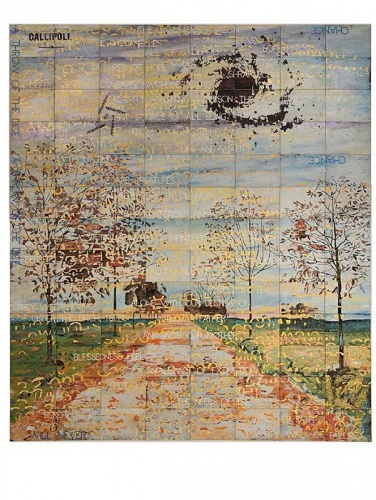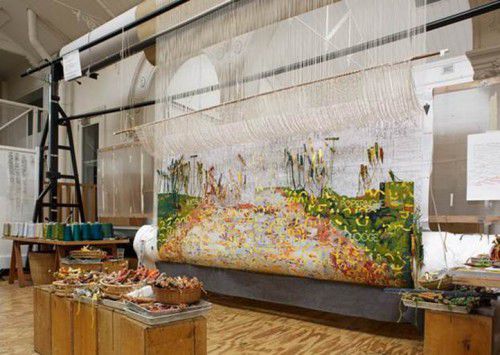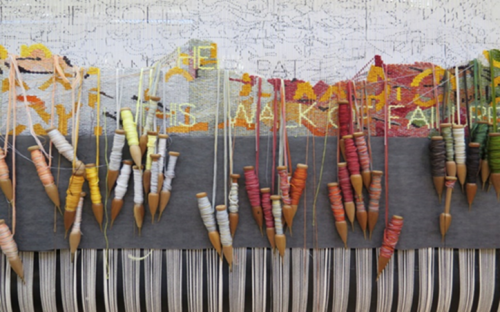A LARGE commemorative tapestry, “Avenue of Remembrance,” based on a painting by internationally known Cooma-based artist, Imants Tillers, was officially unveiled this morning at the Australian War Memorial.

Imants Tillers, Avenue of Remembrance, 2014, oil on board, 3.27 x 2.83m, photo courtesy of the artist
Tillers is best-known in Canberra for his huge 1985 Kosciuszko painting “Mount Analogue,” and the subject to fa major retrospective at the National Gallery of Australia in 2006, and in creating his painting as a response to the centenary of the First World War, he drew on the Gallipoli letter, an 8,000 word document, written by Keith Murdoch to Prime Minister Andrew Fisher in 1915, one of the National Library of Australia’s treasures.
The commemorative tapestry was commissioned in November 2014 by the Memorial through Melbourne’s Australian Tapestry Workshop and was made possible through a donation from the Geoff and Helen Handbury Foundation.

Imants Tillers, Avenue of Remembrance, commemorative tapestry commission work in progress. Photo by Jeremy Wehrauch
The 3.3m by 2.8m tapestry, which took over 2,380 hours to complete, has was hung in the Stairwell gallery of the Australian War Memorial before Anzac Day. This is the first time a major tapestry has been displayed at the Australian War Memorial.
Present at the launch this morning were the director of the Australian War Memorial, Dr Brendan Nelson, Dr Geoff Hanbury, the director of the Australian Tapestry Workshop, Antonia Syme and Tillers.
The artist has written of the process:
The passionate and urgent tone of Murdoch’s letter and sometimes, even his turn of phrase (“congealed incompetency”), immediately struck a chord with me when I first read it. Also by coincidence, it seemed to me that I had already been using similar expressions in many of my paintings over the last decade. To name a few:
“There’s not a shred of hope”
“Stupefied by circumstance”
“The appalling silence”
“Purified by tears”
“A victim of what is infinitely close at hand”
These were paintings reflecting on mortality, being, time, loss, grieving and remembrance, perhaps prompted by the death of my parents and several close friends in that passing decade. Typically these paintings combined image and text into a kind of visual spatial poem and I decided to use a similar approach to this project.
Also with this tapestry design, I decided to eschew an exclusive focus on the tragic but nation-defining event that was Gallipoli (and its geography and topography) and to make reference to the whole of Australian participation in World War I. Thus the names of places where Australians were buried (rather than the actual theatres of war) are quoted as ready-made poetic elements in my design. Thus familiar names such as “Anzac Cove”, “Shrapnel Valley”, “Lone Pine” appear alongside other Middle Eastern locales: “Jerusalem”, “Gaza”, “Beirut” and “El Alamein”. But the majority of the resting places of our war dead are European and less familiar – French and Belgian places on what was called the Western Front: “‘Ypres”, “Polygon Wood”, “Poperinghe”, “Zonnebeke”, “Fromelles’”, “Villers-Bretonneux”, “Peronne”, “Fleurbaix” to name just a few.
Commemorative tapestry, “Avenue of Remembrance” Western Courtyard gallery, AWM.
The post Tillers painting becomes WWI commemorative tapestry appeared first on Canberra CityNews.
